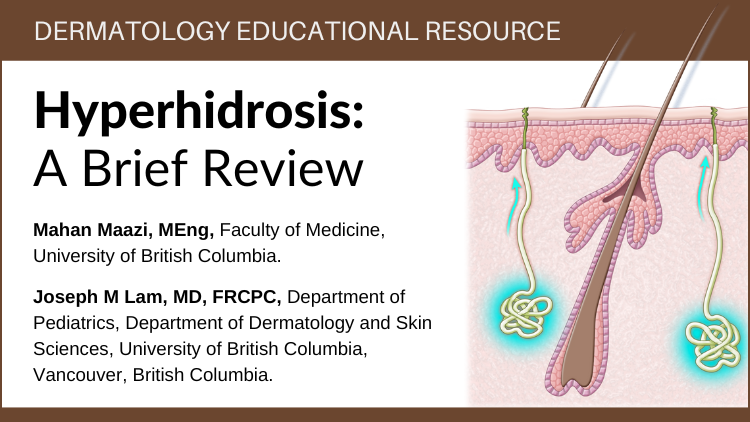
Members of the College of Family Physicians of Canada may claim one non-certified credit per hour for this non-certified educational program.
Mainpro+® Overview
Mahan Maazi, MEng, Faculty of Medicine, University of British Columbia.
Joseph M Lam, MD, Department of Pediatrics, University of British Columbia, Department of Dermatology and Skin Sciences, University of British Columbia.
Abstract
Hyperhidrosis (HH) is a disorder of the eccrine sweat glands causing excessive sweating. It is caused by hyperactivity of the sympathetic nervous system resulting in excessive release of acetylcholine and activation of the sweat glands. Primary essential HH is thought to have a large genetic component, while secondary HH is the result of an underlying condition or medications. HH will often cause excessive sweating in areas with a high density of eccrine sweat glands that include the palms, soles, face, head, or axillae. Diagnosis is largely based on history and physical which can help differentiate between primary and secondary HH. Hyperhidrosis can have a significant impact on quality of life. Management includes identifying and avoiding triggers, the use of topical antiperspirants, and advanced therapies in recalcitrant cases (such as tap water iontophoresis, botulinum toxin injection and surgical options).
Key Words: hyperhidrosis (HH), primary (essential) hyperhidrosis, secondary hyperhidrosis, excessive sweating, eccrine sweat gland.
Introduction
Hyperhidrosis (HH) is a disorder of the eccrine sweat gland that results in excessive sweating.1,2 Although the cause of HH is poorly understood, it is thought to involve autonomic nervous system dysfunction causing overactivity of normal eccrine sweat glands.2 HH can be subdivided into primary (essential) and secondary hyperhidrosis. Primary hyperhidrosis is often idiopathic and has a focal, bilateral, and symmetric distribution. It typically affects the palms, soles, axillae, craniofacial region, and groin.1,2 Secondary hyperhidrosis is caused by systemic diseases and/or medications and presents in a more generalized and asymmetrical distribution.1,2 Primary HH is more common and represents approximately 93% of all cases.2 It often begins between 14 and 25 years of age, while secondary HH often presents after 25 years of age.2 Before diagnosing primary HH, secondary causes must be ruled out.1,2 HH is not life threatening, but can cause significant patient distress, and can interfere with daily activities, social interactions, and interpersonal relationships.1-3

